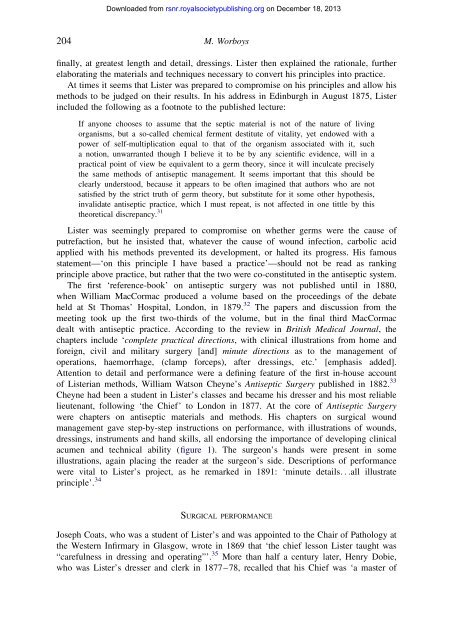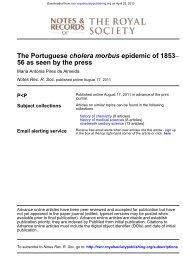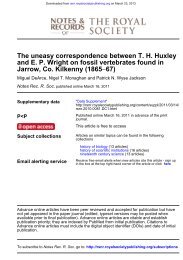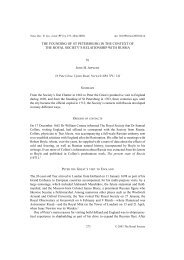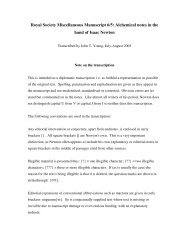JOSEPH LISTER AND THE PERFORMANCE OF ANTISEPTIC ...
JOSEPH LISTER AND THE PERFORMANCE OF ANTISEPTIC ...
JOSEPH LISTER AND THE PERFORMANCE OF ANTISEPTIC ...
Create successful ePaper yourself
Turn your PDF publications into a flip-book with our unique Google optimized e-Paper software.
Downloaded from rsnr.royalsocietypublishing.org on December 18, 2013<br />
204<br />
M. Worboys<br />
finally, at greatest length and detail, dressings. Lister then explained the rationale, further<br />
elaborating the materials and techniques necessary to convert his principles into practice.<br />
At times it seems that Lister was prepared to compromise on his principles and allow his<br />
methods to be judged on their results. In his address in Edinburgh in August 1875, Lister<br />
included the following as a footnote to the published lecture:<br />
If anyone chooses to assume that the septic material is not of the nature of living<br />
organisms, but a so-called chemical ferment destitute of vitality, yet endowed with a<br />
power of self-multiplication equal to that of the organism associated with it, such<br />
a notion, unwarranted though I believe it to be by any scientific evidence, will in a<br />
practical point of view be equivalent to a germ theory, since it will inculcate precisely<br />
the same methods of antiseptic management. It seems important that this should be<br />
clearly understood, because it appears to be often imagined that authors who are not<br />
satisfied by the strict truth of germ theory, but substitute for it some other hypothesis,<br />
invalidate antiseptic practice, which I must repeat, is not affected in one tittle by this<br />
theoretical discrepancy. 31<br />
Lister was seemingly prepared to compromise on whether germs were the cause of<br />
putrefaction, but he insisted that, whatever the cause of wound infection, carbolic acid<br />
applied with his methods prevented its development, or halted its progress. His famous<br />
statement—‘on this principle I have based a practice’—should not be read as ranking<br />
principle above practice, but rather that the two were co-constituted in the antiseptic system.<br />
The first ‘reference-book’ on antiseptic surgery was not published until in 1880,<br />
when William MacCormac produced a volume based on the proceedings of the debate<br />
held at St Thomas’ Hospital, London, in 1879. 32 The papers and discussion from the<br />
meeting took up the first two-thirds of the volume, but in the final third MacCormac<br />
dealt with antiseptic practice. According to the review in British Medical Journal, the<br />
chapters include ‘complete practical directions, with clinical illustrations from home and<br />
foreign, civil and military surgery [and] minute directions as to the management of<br />
operations, haemorrhage, (clamp forceps), after dressings, etc.’ [emphasis added].<br />
Attention to detail and performance were a defining feature of the first in-house account<br />
of Listerian methods, William Watson Cheyne’s Antiseptic Surgery published in 1882. 33<br />
Cheyne had been a student in Lister’s classes and became his dresser and his most reliable<br />
lieutenant, following ‘the Chief’ to London in 1877. At the core of Antiseptic Surgery<br />
were chapters on antiseptic materials and methods. His chapters on surgical wound<br />
management gave step-by-step instructions on performance, with illustrations of wounds,<br />
dressings, instruments and hand skills, all endorsing the importance of developing clinical<br />
acumen and technical ability (figure 1). The surgeon’s hands were present in some<br />
illustrations, again placing the reader at the surgeon’s side. Descriptions of performance<br />
were vital to Lister’s project, as he remarked in 1891: ‘minute details...all illustrate<br />
principle’. 34<br />
SURGICAL <strong>PERFORMANCE</strong><br />
Joseph Coats, who was a student of Lister’s and was appointed to the Chair of Pathology at<br />
the Western Infirmary in Glasgow, wrote in 1869 that ‘the chief lesson Lister taught was<br />
“carefulness in dressing and operating”’. 35 More than half a century later, Henry Dobie,<br />
who was Lister’s dresser and clerk in 1877–78, recalled that his Chief was ‘a master of


